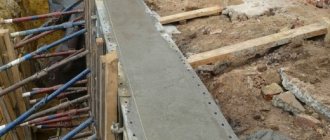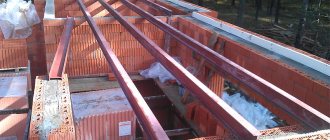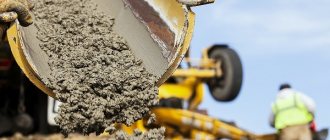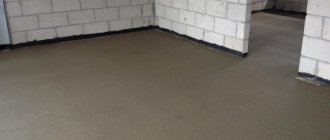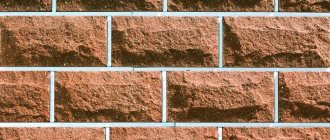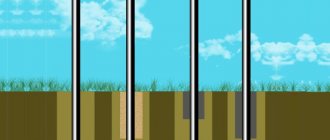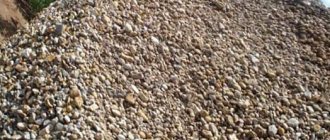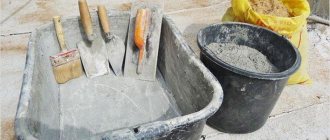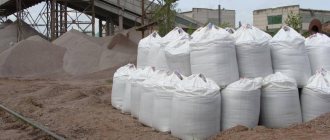In order for the fencing of the site to be reliable and stable, it is necessary to pour a foundation under it. And this does not depend on the material of the fence; a foundation is needed for concrete, brick and metal fencing.
To fill the foundation correctly and in accordance with all standards, you need to take into account several factors. As a rule, a strip or pile foundation is used for a fence, and the right concrete for it is the key to a strong, durable and reliable fence.
Just like for a garage, buildings on a summer cottage or a residential building, for the foundation of a fence it is necessary to take into account the type of soil, know the degree of its freezing and the depth of groundwater. An accurate calculation will help you save on building materials without losing the quality of the fence.
Specifics of using concrete mixtures
Concrete mixtures are widely used in the construction of enclosing structures. Three directions:
- the first is the creation of elements of enclosing structures from precast concrete;
- second – concreting the supports (pillars);
- third - creating a foundation for the foundation.
Let's focus on the last two. To create structural elements of fences you need molds, premises, special tools and skills. This is a topic for a separate article. But in this case, concrete grades from M250 to M350 are used.
So, the grade of concrete for fence posts can be minimal. M100 (B7.5) is ideal for backfilling; it is a light mixture and one of the most affordable offers on the market. As a rule, these are fences made of forged metal and wooden structures, corrugated sheets, and archaic asbestos-cement slate is also often found. The calculation of concrete for fence posts directly depends on the material chosen for the fence; the lighter it is, the shallower the installation depth of the posts, the lower the consumption of concrete solution.
Bricklaying: work rules
The brickwork is placed on a drainage pad. The width of the foundation is determined by the height of the fence. For every meter of the enclosing structure, one row of bricks is laid in width. It turns out that to create a meter-long fence, a 1-row foundation is sufficient; for a 2-meter structure, the base must be double-row. As for the depth of the trench, for a fence 1 m high it should go down 15 cm. For 2-meter fences, the recommended depth of the ditch is twice this value.
How to calculate the number of bricks that will be spent on creating a foundation for a fence? To determine the number of rows, craftsmen are usually guided by the height of the brick. The standard brick is a material with a height of 6.5 cm. If the trench is dug to a depth of 30 cm, add 10 cm to the above-ground part of the base and divide the result by 6.5. Approximately 6 rows.
Foundation arrangement
If artificial or natural stone is used to construct a fence, you cannot do without a foundation, usually strip or columnar, with rare exceptions (other options are pile and combined). The fence needs to be filled with concrete. And here you should take into account how materials from artificial or natural stone are used; the composition of concrete depends on this. There are two main use cases:
- facing and installation of support columns, installation of the base, in this case the load on the base is insignificant, the grade of concrete for the fence can be used in the range from M100 (B7.5) to M200 (B15);
- erection of a fence, that is, a wall is erected from brick, natural stone or a combination of materials, in this case the load on the base increases and the concrete grades are correspondingly higher, ranging from M150 (B10 or B12.5) to M250 (B20).
And one more small BUT. When choosing concrete for the foundation of a fence, consider the level of groundwater, soil type and freezing depth. It may be necessary to pour concrete with increased moisture resistance or a higher grade. Still don’t know what concrete to choose for a fence? Contact us! Megalit specialists will provide professional advice and help determine the best option. The main thing is to choose concrete, the grade of which will provide guaranteed structural strength, the required operational and technical characteristics of the fences
An increasing number of people, in addition to an apartment in the city, want to have a country house, a small cottage or just a dacha in order to be able to relax and relieve stress. For many, the process of building a country house or cottage turns into a kind of hobby. I would like to do something with my own hands, because this not only allows you to gain additional experience and knowledge, but also then independently maintain the household in order.
Often the stumbling block is the construction of a fence around the site and the need to mix the concrete for the fence posts yourself. If you can order construction equipment to erect a fence from the street side, then inside the yard everything is much more complicated, some sections can only be strengthened manually, and even more so if we are talking about repairing an old fence, when beds have already been laid out around a country house, a garden has been planted or standing outbuildings.
The most convenient and cheapest option for installing a fence between cottages is a chain-link mesh stretched over posts. It lets in plenty of sun, and it’s quite easy to put it on. We advise you to prepare concrete yourself to cast fence posts. This will eliminate the need to buy several products from the factory and pay for their delivery.
Buy or make it yourself
People who buy ready-mixed concrete usually do not have the time or desire to prepare it themselves.
It is worthwhile to be puzzled by the purchase of concrete when planning a monolithic and volumetric structure: thanks to the additives and plasticizers added at factories, the foundation will be of better quality and stronger. In the tank of the concrete mixer truck, the solution is constantly mixed and does not harden. Disadvantages of this method:
- The equipment is ordered for 1-2 hours, during which time you need to manage the installation, otherwise the mixture will turn into garbage.
- It is necessary to clearly calculate the volumes. They should not be smaller than the tank of the special transport called - some manufacturers require payment for its entire volume.
- It is impossible to check the quality of the mixture before pouring. To avoid mistakes, they usually order a higher and more expensive brand.
- Delivery to a remote home or cottage in need of fencing will cost a large sum.
But even without taking into account possible overpayments, it is more profitable to make concrete for the foundations of light fences yourself. To make a cube of mortar similar to the two hundredth grade, you will need 0.1 cubic meters of cement - approximately 465 rubles, 0.3 m³ of sand - 165 rubles and 0.5 m³ of crushed stone - 440 rubles. Total: 1070 rubles.
Even taking into account the costs of water and electricity, the total amount will not exceed 1,200 rubles. The minimum price of the finished mixture with delivery is 2200 rubles.
If you know where to borrow a concrete mixer, the savings come out - a thousand per cubic meter.
The advantage of mixing concrete yourself is that construction work can be carried out in stages. This is important for those who build a fence with their own hands, without hiring a team of builders. The downside is the expense of renting or buying a concrete mixer and the abundance of dirt and construction waste.
Secrets of proper concrete
To obtain a grade of mortar of the required strength, you should adhere to the proportions for preparing concrete for fence posts. The mixture is prepared as follows: take 1 part cement, 2 parts sand, 4 parts crushed stone, the amount of water will be equal to half the amount of cement. Each component of the mixture has certain requirements. Since concrete for fence posts must be strong (not lower than M200), cement should be purchased not lower than M400. The sand must be washed (river) without any admixtures of clay or soil (clumps of clay that get into the solution, freezing in winter, “tear” the concrete).
Casting and concreting of pillars
Casting concrete fence posts has become widespread due to several undeniable advantages. Firstly, hand-cast products are cheaper than purchased ones, and there are no problems with delivery and sizes. Secondly, the concrete for the fence posts is mixed independently, and this is a guarantee of its quality. Thirdly, the pillars can be not only of different heights, but also shapes (rectangular, round, narrow, wide). Fourthly, they differ from purchased ones in the presence of embedded parts (this can be reinforcement or a wooden block) for the convenience of attaching gates, gates, and fence sections.
It is preferable to prepare the concrete mixture in a concrete mixer, but you can also do it manually, using any available container: an old bathtub, a zinc trough, a large sheet of tin with curved sides. This is low-tech, but allows you to save on purchasing equipment.
When pouring concrete, be sure to compact the mixture using any tool that produces vibration (for example, a hammer drill), or pierce it with reinforcement to remove excess air.
To create rectangular or round pillars, you will need formwork of different shapes. In the first case, it will be enough to make a collapsible box from the boards (tighten the sides with screws), and in the second, you can use a pipe sawn in half and fastened with clamps. Let's look at each method.
Square post
Building a box from boards is not a difficult task (Fig. 1). However, there are several nuances that must be observed to ensure beautiful and durable products.
Firstly, the walls of the mold must be smooth; plywood, planed boards, boards covered with plastic or lined with plastic film are perfect for this. The appearance of the cast product and the problem-free removal of formwork depend on this. To prevent the solution from sticking to the formwork, its inner surface must be lubricated with machine oil.
Secondly, the pillar must be reinforced from the inside. There are many options: a welded frame of four rods (in extreme cases, welding can be replaced by tying the reinforcement), laying a reinforcing mesh bent in a V shape, you can simply lay the reinforcement in the process of layer-by-layer pouring. For reinforcement, steel rods with a diameter of 8 to 16 mm are suitable (depending on the thickness of the column and the load). The recommended length of the product is 2.5-3 meters (1/3 of the post will go into the ground).
Don’t forget to place embedded parts (metal, wood) in the places where you plan to attach the fence and hinges for the wicket or gate.
Pouring concrete can be done in parts in the following order:
- lay a layer of concrete approximately 2 cm thick, install mortgages and lay two reinforcement bars (or a welded reinforcement cage);
- the next layer of mortar is laid at 2/3 of the height of the form, and the remaining reinforcement is laid. At this stage, the resulting layer of concrete must be compacted so that the air voids disappear (you can simply “poke” thoroughly along the entire length with a piece of reinforcement);
- lay the last layer of concrete to the top of the form and level it. The concrete will take a couple of days to harden.
Round post
Unlike the previous option, round posts can be poured directly into the holes. To do this, holes are drilled with a hand drill or a motorized drill (auger diameter 200 mm) to a depth of 140-150 mm. Sand is poured into the bottom of the hole, then gravel (30 cm) and compacted. This creates a drainage cushion under the post so that it does not warp during the winter.
The formwork for a round post is made from two halves of a pipe; it is better to take a thick-walled plastic one with a diameter of 150-250 mm. A pipe 2 meters long is cut in half, then twisted either with wire or clamps. In the pipe we drill holes at the bottom, in the middle and at the top - for the mortgages.
Pouring technology
Technologically, pouring a pole at the installation site is much easier than moving and digging in a ready-made one. The solution can be mixed in a prepared container near the concreting site. For a hole one meter deep, with a diameter of 400 mm, it takes a batch of concrete to mix 2 buckets of cement, 4 sand and 8 small gravel. You will need a bucket and a half of water.
Pile
The choice depends on the mass of the structure. When erecting a fence with light weight, a pile type of foundation is poured. Its main advantage is simplicity and accessibility. And since the main task of such a foundation is simply to hold the pile in a vertical position, concrete can be selected from a range from M100 to M200.
Welded foundation structure
This base is a round pipe that has a tip and a blade. The installation method is quite simple. Piles are screwed in to a depth of 1.5 meters and filled with concrete mixture. Very often this type of foundation is used in swampy areas.
M100 is suitable for pouring the base in the presence of light soil and rock formations. This is the cheapest type of mixture with the largest number of large fillers.
Concrete for the foundation of the M150 fence is also called “skinny”, since it has a minimum percentage of binding elements and a large proportion of large particles.
M200 is more suitable for areas that have a certain angle of inclination, and is used in difficult soil conditions. The cost of such concrete will be much higher and will not always justify its price.
Calculation of the amount of concrete for 10 fence posts
At home, it is easy to calculate the amount of concrete needed to cast fence posts. To do this, you need to multiply the height of a square pillar by its perimeter and get the volume, then multiply by the number of pillars. So we will calculate how many cubic meters of concrete we need. Experts believe that 1 m3 of concrete is equal to 25 linear meters of a 20x20 cm column, which is a little more than 10 columns. You can calculate concrete for round fence posts, knowing their height and cross-sectional area, using the formula:
S = 3.14 x R2 (R is the radius of the pillar)
For a column with a diameter of 20 cm, the volume will be 0.063 m3. For ten pillars you will need 0.63 cubic meters of solution. Thus, round fence posts will cost almost twice as much as square ones.
A taller fence requires more massive posts, and posts for heavy metal gates are also made more massive.
Precise installation and durable concreting of support posts for a country fence is a guarantee that the fence will last for many years without distortions or falls. However, first you need to determine what material the supports are made of and what requirements they must meet:
- Nobody changes the fences every year. Therefore, the columns must be made reliable with the expectation of long-term operation with minimal maintenance costs.
- The supports should easily, with a certain margin of safety, bear the load from spans, wind influences, snow drifts, and other dynamic influences. This is especially true for fencing those areas that are located in open areas not protected by forest.
In addition, the posts, as an important part of the fence, should look attractive and fit well into the overall concept of not only the fence, but the entire site. They are made of wood, metal, reinforced concrete, asbestos cement. They are built from bricks and blocks. Each option has its advantages and disadvantages, but all have a common requirement - reliable installation of fence supports.
When should you choose a tape?
Installation of the structure on a monolithic strip base is necessary in the following cases:
- Heavy materials are used to make the cladding.
Corrugated sheets are metal sheets with a continuous structure, the weight of which is quite large. To increase the service life of the fence, it is advisable to choose tape. The same applies to the installation of structures with forged elements. - The pillars are planned to be made of brick. They create excessive pressure on the ground and need a strong foundation that can withstand a large load-bearing load.
- The site is located on a slope from the road, and in the spring rainwater flows into the area.
- There are domestic animals living on the site, which regularly try to escape by digging.
Alternatives:
- Columnar supports.
- Rubble foundation.
- Ribbon-column design.
You can also use collection tape. It is installed faster due to the fact that there is no need to mix the concrete and wait for it to harden. Therefore, if deadlines are running out, it is better to choose it.
It is worth considering that the cost of such a foundation is usually higher, because the price of the blocks themselves is quite high and in this case it will not be possible to do without special equipment. Therefore, monolithic tape is often chosen for the fence.
Advantages and disadvantages
The advantages of installing such a base include the following factors:
- Large bearing load, making it possible to install a fence of almost any height.
- Resistance of the structure to random and directed mechanical impacts, contact with moisture, and temperature changes.
- Possibility of construction on a site with a slight angle of inclination.
- Ensuring a solid appearance of the fence.
- Long service life: with proper arrangement, the tape base retains its qualities for 50-70 years or more.
Main disadvantages:
- Under such a foundation, you will need to dig a trench along the entire perimeter: this not only increases the cost of construction, but also makes it longer and more labor-intensive.
- If you build on heaving or unstable soil, you may encounter deformation of the monolith due to movement.
- After pouring, you need to wait several weeks so that you can install the pillars: if the concrete does not have time to dry, premature installation of the frame will lead to cracking.
Factors affecting the installation depth of racks
Correctly determining the depth of the fence support posts means maintaining its integrity under unfavorable operating conditions. When performing calculations, the following factors should be taken into account:
- design features of the structure and its functional tasks;
- the magnitude of the maximum load taking into account external influences;
- characteristics and topography of the soil in a given area;
- level of occurrence and possible rise of groundwater;
- the degree of greatest soil freezing in a particular area.
To ensure better operating conditions and structural strength, fence posts must be buried below the freezing point of the soil.
Important! Correct calculation of the installation depth of fence posts is the main indicator of the stability of a structure. Since negative environmental influences and increased loads can cause partial or complete destruction of the entire structure.
In addition to determining the depth of the racks, it is equally important to secure them correctly. Depending on the operating conditions, there are several methods. Today we will talk about how to properly concrete pillars.
But this option is not always justified. If the site for the construction of a fence is located on soils with a high level of soil moisture, then when freezing, the water expands and can literally squeeze the concrete post upward. Thereby compromising the integrity of the overall structure. In this case, it is better to use the method of driving pillars, following the example of working with piles.
Construction Features
In each specific case, certain problems may arise due to external factors. In this case, you will need to take into account a number of nuances and additional actions.
How to do it correctly on a slope?
The first step is to fill the slope and level it, but such a process can be labor-intensive. For this reason, a stepped foundation is used.
It consists of one tape, which differs in thickness under each span. This method will create a stable base that will support the structure.
With a slight slope, you can install a fence with a slope angle that is equal to the slope. In this situation, concreting is carried out in parts along delimited areas.
With brick pillars
Brick pillars have a large mass, which requires an increase in the foundation base. With this option, it is additionally taken into account that the required trench depth is lower than the soil freezing level.
The base of the pillar itself is buried along with the main tape, which ensures uniformity and increases the load-bearing capacity. Read more here.
From corrugated sheets
When using corrugated sheeting, it will be necessary to install pillars before laying the reinforcement frame. The pillars are placed every 1-2 meters with a depth of 0.8 - 1.2 m into the ground.
Read more about the construction of a fence from corrugated sheets on a strip foundation here.
Types of concreting
When a fence, even from the simplest materials, rests on a solid foundation, it always looks dignified and presentable. Let's look at the most common technologies for concreting fence posts.
Partial concreting
This method is used when performing work on stable soils and under low loads. The essence of the method is as follows:
- In a pre-prepared hole, we install a support on a dense cushion of a mixture of sand and crushed stone.
- We cover the walls of the pit with insulating material. You can use regular roofing felt.
- Approximately half the height of the hole, we fill the fence support with rubble stone or coarse crushed stone, and if the post is metal, then we simply drive it into the ground.
- We prepare a concrete mixture of 1 part Portland cement (M400 brand is the most suitable), 3 parts sand and 5 parts crushed stone. Fill the pillar with the prepared mixture. We do this in portions, carefully compacting each layer.
What brands are there?
The choice of concrete mix brand depends on the weight of the fence itself and the composition of the soil. Inexpensive concrete M100–150 contains many large fractions. But that doesn't mean you should give it up. To make the basis of a not too massive metal profile fence in light and rocky soils, it is quite suitable.
Such a foundation can be created even on difficult soils and sloping areas. The main thing is to choose the fence itself that is not too massive.
On a foundation made of M250 concrete, it is possible to erect a massive structure that is well resistant to groundwater, rain, snow and wind. M300 holds pressure up to 300 megapascals. This composition is required on soils prone to freezing.
Higher grades increase the strength of the fence base, but their use is not cost-effective.
